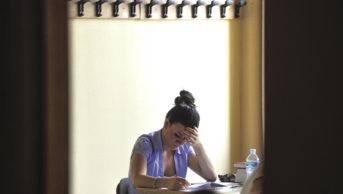
Shutterstock.com
Pharmacy students that join university courses with lower A-level requirements or through ‘clearing’ are more likely to fail the General Pharmaceutical Council (GPhC) registration assessment at their first sitting, figures compiled by the Guild of Healthcare Pharmacists (GHP) show.
The GHP used the Freedom of Information (FoI) Act to obtain details from pharmacy schools on the A-level performance of student entrants (mean and median score of three A-levels) and the proportion of their student intake entering through clearing. It matched these data against figures published by the GPhC on the performance of students in the final registration assessment by school.
Students attending pharmacy schools that accepted those with lower mean or median A-level grades, or took more students through clearing, were more likely to fail the GPhC assessment on their first attempt, the findings showed. Clearing allows students to apply for courses that still have places available, should they have not received any offers, rejected all their offers, or missed the conditions of their offers.
David Miller, a former GHP president who coordinated the FoI investigation, says: “This is the first time we have data in the public domain that shows a clear association over each of the last five years between entry criteria, the number taken through clearing and the final entry exam success.”
Since 2000, the numbers of students entering the pharmacy profession in the UK has more than trebled from 4,000 to over 12,000 a year, and correspondingly the number of pharmacy schools has grown from 12 to 27. Around 45,000 pharmacists currently work in the NHS and in community pharmacies, and an additional 2,500 join the register each year.
Average pass rates at the preregistration year stage have dipped dramatically from 90% (2009–2011) to 79% in the past three years (2012–2015). The GHP warns that this suggests 3,000 of the more than 12,000 current pharmacy students will fail the registration exam on their first attempt.
“For each of those students that is a serious issue financially and career-wise, and that demonstrates significant inefficiency in the training of pharmacists,” says Peter Noyce, professor of pharmacy practice at the University of Manchester, who was co-chairman of the board of the Modernising Pharmacy Careers programme.
GHP president Vilma Gilis says the increase in student numbers has “been driven by the commercial interests of some universities, often with a focus on quantity achieved through a reduction in the student quality. This has now led to a situation where over a quarter of students can no longer meet the basic requirements of a professional entry examination. This situation is unacceptable for both the graduates and their future employers.”
A report from the GPhC, following a visit by inspectors to University of Central Lancashire to accredit its master of pharmacy course after a major review, found that the school was “under pressure from senior management to increase student numbers, and this had been achieved through reducing the required standard of entry qualifications during the clearing process”. As a result, there had been a “marked over-recruitment of students” in September 2014, with 164 recruited compared with the accredited number of 120.
Lottie Bain, president of the British Pharmaceutical Students’ Association, says: “It is obviously a concern if entry requirements are being reduced purely to recruit higher numbers of students, or to maintain numbers with increasing competition from the opening of new schools.
“As an association we appreciate that A-level grades alone may not always be the best indicator of somebody’s capabilities and suitability to train as a pharmacist, and we support the consideration of additional experience and/or qualifications where appropriate.”
Miller warns that while some universities may achieve short-term financial gains, they will be at risk of the long-term viability of pharmacy if they drive down the overall quality of intake.
“Pharmacy will cease to be viewed as an attractive profession due to the numbers of graduates unable to join the register, potentially deterring more able students to other courses and further reducing intake quality,” he says.
Noyce says that students attending schools with lower entry requirements may be disadvantaged by more than their own academic ability. Students from schools of pharmacy that have the best reputations probably get stronger preregistration places because employers looking for the best students will take students from what they consider to be the best schools, he explained.
The GPhC says entry requirements are one of a number of important factors it considers when accrediting or re-accrediting pharmacy education providers. “Entry requirement issues are being considered as part of our wider review of our standards of initial education and training and we will be seeking views on the right regulatory approach,” it says.


